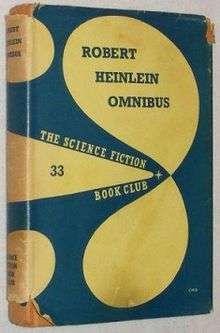The Robert Heinlein Omnibus

The Robert Heinlein Omnibus[1] is an anthology of science fiction one novel and two short stories by Robert A. Heinlein published in 1958[2]
- Beyond This Horizon. (1942)
- The Man Who Sold The Moon. (1950)
- The Green Hills of Earth. (1947)
Beyond This Horizon is a novel of an economic utopia, but as is inherent in most of Heinlein's stories, there are a couple of serpents. The search for meaning in life is more important, as genetic engineering has wiped out physical suffering, emotional suffering becomes more acceptable. Any shortcomings in an individual generate suffering for that person. Seeking fulfillment is an end unto itself, and producing genetically engineered "perfect" offspring is a social requirement. Heinlein presents a plethora of philosophical beliefs mixed with hard science, with particular emphasis on reincarnation and genetics in this story.
The Man Who Sold the Moon is an application of basic late 19th and early 20th Century American economic theory to science fiction. Delos David Harriman is the embodiment of what Heinlein sees as a future example of the 19th Century "Robber Barons" of the American economy. Successful with everything he does, Harriman has enough credibility to gain sufficient financial backing to send a man to the moon and back. Mixing a little economic, social and political intrigue, completed with some financial underhandedness, Harriman proves it can be done and with that success, pushes humankind out to colonise the moon. In many ways, this story embodies the same sort of mythological adventurous American spirit now found in the histories of westward expansion and land grabbing. It is also a salutary and sobering look at what success can mean for the individual. All Harriman wants to do is go to the moon himself, but his success prevents him from doing so. His business partners gang up on him and prevent him from leaving the Earth, until he finally gets to make the trip himself, the last, and for him the most rewarding, act of his long life.
The Green Hills of Earth is a story in a very different vein than the other two. Space travel is well established, commonplace, the "hero" of this story is a blind minstrel. Like the minstrels of another era, "Noisy" Rhysling travels the space lanes writing and performing his songs. Rhysling is tolerated as he was a former spaceman himself, and his musical talents are his stock in trade. Realising he is dying, Rhysling is returning to Earth, his birthplace to be buried under those green hills. Trouble develops in the spaceship's engines and to fix it, is certain death for the repairman. Knowing his time is limited, and still having the required skill set, Rhysling volunteers to fix the problem. While he is in the engine room, Rhysling maintains a chat with the bridge crew, and in his reveries, begins to write the final incarnation of the song that has been with him for a long time, ″The Green Hills of Earth″. In saving the ship, Rhysling is the hero of the day and the song becomes the anthem of a new age. While the idea of the "Green Hills of Earth" was not Heinlein's, it was C.L.Moore who used the idea first, and along with her then husband, Henry Kuttner, gave it some background across several of their own works, it was Heinlein that refined its origin with this story.
Overview
These stories each hold a special element that underpins the perception of Heinlein as a truly great SF writer. At the time of original publications of these stories, SciFi was the lunatic fringe of authorship, laughed at, at best, scorned and derided at worst. Consider though, the themes. Genetic engineering was not "invented" by Heinlein, stories of "Ubermensch" had been around for decades, but it was brought to the heart of a society for the first time by Heinlein. Harriman may be a mixture of Vanderbilt, Carnegie and Morgan, but can still be identified as having a much grander vision along with someone like Elon Musk. Music has always been a part of human culture. From the most primitive to the most sophisticated cultures, music can bind and identify a culture or sub-culture. In the future, perhaps the most rarified sub-culture will be the men and women who ply our spaceways, and who's to say there will not be a Rhysling who will give all the people of Earth a new anthem? It is the fact that Heinlein identified these common threads in all human societies that marks him out as a master of his craft.
What really makes Heinlein stand out from the rest of the authors at the time, was his willingness to examine the sacred cows of societies, and slaughter them occasionally. These three stories each, in their own way, do just that, and while they may be overly sentimental in ways, or overly callous on other ways, they do not get caught up in trying to justify any particular social, scientific, political or economic view. Instead, they treat the reader to Heinlein's rather eclectic view of how things could be, not how they should be. Given the rather individualistic, pragmatic Heinlein, these stories present similar western social backgrounds, the mixture of individual effort with social dynamics but without a socialist perspective, tied in with eastern mysticism in unexpected ways. Again, Heinlein wasn't the first to do this, but he did make us sit up and take notice.